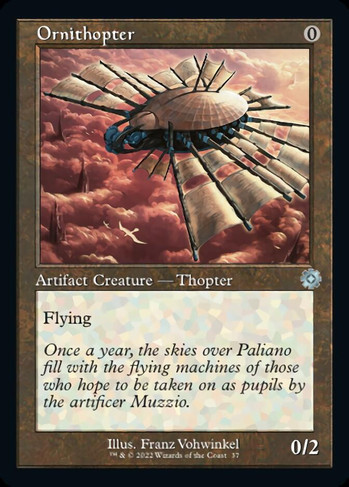Deck of the Week: Modern 8-Cast Affinity
- Connor Kirkwood
- Apr 19, 2023
- 9 min read
Updated: Aug 23, 2023

Affinity’s History
Throughout Magic’s history, artifacts have historically been Magic’s most powerful card type. Six of the nine cards in the Power Nine are artifacts. Memory Jar was one of Wizard’s first emergency bans. Living Weapons and Swords from the Mirrodin Besieged block caused Cawblade to rise to power. And, of course, the original Mirrodin introduced us to Affinity, causing numerous bans throughout the years.
Affinity has been an explosive archetype in every format that often leads to bannings. Fifth Dawn was released in June of 2004, and nine months later, Wizards banned Arcbound Ravager, Disciple of the Vault, Darksteel Citadel, and all five artifact lands in Standard, all due to Affinity being too powerful.
When Modern was introduced in 2011, the five artifacts lands and Chrome Mox were banned from the very start to prevent Affinity from dominating the format. Even with the ban, Affinity remained a powerhouse in Modern until the banning of Mox Opal in 2020.

Pauper has a similar tale: Affinity became so powerful that in 2021 Wizards banned Soujerner’s Companion, and when the deck continued to be too powerful for Pioneer, they banned the deck’s key card, Atog. Even after banning two of the most powerful cards in the deck, Affinity remains a tier-one deck in Pauper, which I proved by carrying it to first place at a local Pauper event. You can find that deck here.
In Legacy, 8-cast has been a powerful deck for quite a while, even adopting the Painter’s Servant combo during the rise of Initiative. Legacy has full access to the artifact lands and a slew of other powerful artifacts that let it prevent your opponent’s powerful abilities with cards like Chalice of the Void while pressuring their life total with cards like Kappa Cannoneer.
After Mox Opal’s banning in 2020, Modern Affinity has been far from the limelight. Considered to be not even a viable deck, most players put away their Ornithopters and Cranial Platings, assuming the deck was dead. However, due to their nature, artifacts will always find a way to claw back into the tier-one meta.
After many years of being unplayable, Modern Affinity has finally returned to the Modern scene and made the top four of this past weekend’s Modern Challenge on MTGO. Being a lover of Affinity, I was overjoyed to see this, and I knew it would be a perfect addition to our Deck of the Week!
What caused the return of Modern Affinity?
In 2021, a set was introduced to Magic that changed the face of every format it was legal in. Modern Horizons 2 made tremendous changes to the Modern format, introducing the pitch elementals, Archon of Cruelty, Murktide Regent, and everybody’s favorite Monkey, Ragavan.
But Modern Horizons 2 also had a strong artifact subtheme, and it introduced cards like Urza’s Saga, Thought Monitor, Soujerner’s Companion, Nettlecyst, and the indestructible artifact dual-lands. These new artifacts sparked some curiosity in old Affinity players, and Legacy 8-cast quickly adopted these and rose to power. While it took a little more time, Modern Affinity is headed in the same direction.
What makes Modern Affinity so powerful?
Modern Affinity has always lacked the prison aspect flaunted in Legacy Affinity, but it makes up for it by being aggressive. As it has always been, Affinity’s game plan is to dump their entire hand onto the battlefield by turn two and then overpower the opponent before they have a chance to play their cards.
The game plan is to play a lot of cheap artifacts, making all our Affinity cards cheap enough to cast. The main deck contains nine zero-cost artifacts, not including 13 artifact lands, and ten one-cost artifacts. Over half of the deck can be played on turn one.
Conversely, the deck plays 16 cards with the keyword Affinity, making up about a fourth of the deck. In most games, we aim to have three to four cheap artifacts in our opening hand to be played on turn one, followed by our powerful Affinity cards on turn two, allowing the deck to take over the game.
The Enablers
Let’s start by looking at the cheap artifacts that allow us to play our Affinity cards. Eight zero-drop creatures in our deck make the deck aggressive and add to the artifact count. Ornithopter has been an all-star in Affinity for a long time, and Memnite has helped to fill a similar role.

The other two cheap creatures are new additions to the deck. Gingerbrute has been added to many decks like Affinity since it can be tutored up with Urza’s Saga and has evasion. Put a piece of equipment onto Gingerbrute, and suddenly you have an unblockable creature dealing lethal in just a few turns.

The second new addition is Haywire Mite, which has seen play in many different decks. Not only is this a cheap artifact, but it can be beneficial in removing your opponent’s Urza’s Sagas and Kaldra Compleats, or any other annoying artifacts or enchantments. And the two life that it gains is no small thing; there are many games against other aggressive decks where that life is the deciding factor between which player dies first.

Affinity also runs several noncreature artifacts that all serve different purposes. The first of these is Springleaf Drum, which can be played on turn one, and if you couple it with an Ornithopter or Memnite, you can generate another mana to cast another artifact.

Relic of Progenitus is your main deck graveyard hate. Use it to slowly erode your opponent’s graveyard or exile it to stop their combo and draw yourself a card. Relic is an excellent card to play in this deck because even if your opponent has no graveyard interaction, it can still be used for your artifact count and cycled for a new card. If your opponent has no graveyard strategies, it is an easy cut for sideboarding.

Shadowspear is an unsuspecting piece of equipment that may look very simple, but it has many uses in Modern. Sometimes it can be equipped to an Urza’s Saga construct to give it trample and push through lethal damage. Sometimes it is used as a life-gain engine, allowing you to race your aggressive opponents easier. In some situations, its ability can even be activated to remove the indestructible keyword from your opponent’s Kaldra Compleat, allowing you to kill it.

Aether Spellbomb is another card that has many uses in this deck. Often it is used to remove one of your opponent’s creatures, whether that’s a giant Murktide Regent that is threatening lethal or a blocker that is standing in your way. Sometimes you will even target your own creatures, protecting them from removal or returning them to your hand so you can recast them for their enter the battlefield effect. Of course, if you have no use for it, it can be cycled to draw a new card.

Welding Jar is a nifty zero-cost artifact that has always provided interesting plays to this deck. Usually, regeneration has explicitly dealt with creatures, so many people falsely assume that Welding Jar regenerates an artifact creature. However, Welding Jar regenerates ANY artifact. Of course, you can target one of your creatures to save them from a removal spell or combat damage. But you can also target one of your other artifacts to put a regeneration shield on it, and if your opponent attempts to shatter it, nothing will happen!
The Affinity
Now we get into the fun part of the deck; the haymakers. You cannot tell me that you don’t enjoy casting a seven-cost card for free. That is exactly what this deck is all about.

The first Affinity card we’re going to look at is actually caught in between an enabler and an Affinity card, because it is both. Frogmite may cost four mana, but due to Affinity, there are many times when this is cast as early as turn one for free. It is not that difficult to get out four artifacts on your first turn, and being able to play a 2/2 on turn one for free is pretty powerful.

The following two Affinity creatures are a little more challenging to cast. Sojourner’s Companion is the new Myr Enforcer, and not only is it a 4/4 beater that you can get out on turn two, but if you find yourself short on mana or artifacts, you can cycle it to find a land. There are many games where if you resolve this on turn two, your opponent doesn’t have enough Lightning Bolts to take it down, and you run away with the game.

The last Affinity creature is also a seven drop, but it’s a little smaller. Thought Monitor may only be a 2/2, but it replaces power with evasion and an enter the battlefield ability. Casting a Wind Drake for only one mana and having it draw you two cards is a powerful effect; imagine if Mulldrifter was a one-drop!

The last card with Affinity in the deck is an oldy but goody, Thoughtcast. You may see some similarities between Thoughtcast and Thought Monitor, as Thought Monitor is simply Thoughtcast with wings. Once you dump your hand onto the battlefield, there may be times when you don’t have enough resources to finish the game. Casting a one-drop divination can help you get there, especially since it often finds you more Thoughtcasts and Thought Monitors to keep you going through your deck.
The Power
While Affinity may seem fun and aggressive so far, it falls short compared to the rest of the Modern meta. After all, Ornithopter may be a flier, but it is only a 0/2. Thought Monitor may draw you two cards, but it takes ten turns to deal lethal damage. Getting a 4/4 Soujerner’s Companion out on turn two may be powerful, but not when your Rhinos opponent is getting two 4/4 rhinos on turn three. What makes this deck viable?

Two cards in this deck make it a viable deck for Modern. The first is one of the primordial reasons why Affinity has been a powerful deck. Cranial Plating was the original Colossus Hammer, before Hammertime came into being. The strategy of old Affinity was to equip a Cranial Plating onto an Ornithopter as early as turn two and kill your opponent in the air.
While Modern has adapted and changed, swinging with a giant flying creature continues to be a valid way to win. With the addition of Shadowspear, you can now make an enormous Ornithopter with lifelink, which will easily outpace your Burn opponents. Cranial Plating turns any of your creatures into lethal threats, giving you the ability to pressure your opponent’s life total quickly and efficiently.

While Cranial Plating helps close out the game fast, Urza’s Saga helps when you have to head into the midgame or run out of resources. Urza’s Saga continues to be one of my favorite cards from Modern Horizons 2, and the use of it in this deck makes me love it even more. At its base, it gives you mana, makes you two constructs, and tutors up a free artifact. That is a lot of value for this deck.
Let’s imagine that Urza’s Saga only generated the two constructs for you. Not only is it a land that also creates two creatures, but in this deck, those creatures are bombs. There are only nine non artifact cards in this deck. That means that almost every single card in the deck makes the constructs bigger. It is not that hard to envision Urza’s Saga making you two 9/9 creatures.
Now let’s add in the fact that Urza’s Saga then tutors for an artifact from your deck. There are nine different cards we can tutor up with its third chapter ability, which are:
Ornithopter
Memnite
Gingerbrute
Haywire Mite
Aether Spellbomb
Welding Jar
Springleaf Drum
Relic of Progenitus
Shadowspear
This means that Urza’s Saga can help you in almost any scenario. Need a creature to equip your Cranial Plating to? Get an Ornithopter or Memnite. Need an evasive creature? Get Gingerbrute. Need to get rid of an opposing Urza’s Saga or Kaldra Compleat? Get Haywire Mire. Need to remove a Murktide? Get Aether Spellbomb. Need to protect your creature? Get Welding Jar. Need more mana? Get Springleaf drum. Need to stop your opponent’s graveyard shenanigans? Get Relic of Progenitus. Need to gain life or push through damage? Get Shadowspear.
The amount of power that a single land in your deck can provide you is absolutely insane. My personal favorite thing to do with Urza’s Saga is to create two constructs and then get your Shadowspear, making your constructs even bigger and giving one lifelink and trample. Out of all of the cards this deck received in the past couple of years, Urza’s Saga is why it is doing so well.
Final Thoughts
I know many people will write off Affinity since it no longer has a powerful Mox, but all I can say is; Scoreboard. Affinity was able to get top four in the Modern challenge alongside tier-one decks like Scam, Hammertime, Murktide, Living End, and Rhinos. No matter what your views are of Affinity, you have to admit that the results speak for themselves.
If you are a lover of Affinity like I am, I highly recommend this deck. It still has all the sweet cards that made me fall in love with the deck in the first place; Ornithopter, Cranial Plating, and Thoughtcast, while also playing with powerful new cards like Thought Monitor and Urza’s Saga.
If you are a fan of dumping your entire hand out on the table and winning the game quickly, you will most likely enjoy playing this deck. This deck sometimes will feel like a combo deck, but with a very aggressive feel to it. If you love Burn but hate how it has no mid or late-game strategy, try out Affinity! It has all the fun of being aggressive toward your opponents, while also playing divination spells!
While I wouldn’t place Affinity in the first tier of the Modern meta, I think it can safely be placed in tier two. It is an aggressive deck that can end the game quickly while still having enough disruption to stop your opponent's strategy. It has a good matchup against slow opponents, pressuring them before they can enact their strategy, and it also has a good matchup against other aggressive decks, being able to out-race them with Shadowspear.
It was a sad day when Affinity was pushed out of Modern, and I couldn’t be happier that it is back. It is a fun deck to play, but it is not overly oppressive on the meta. It won’t warp the format or anything drastic like that, but players will have to start playing more Brotherhood’s End in their sideboards!

You can find the original decklist here.



















Comments